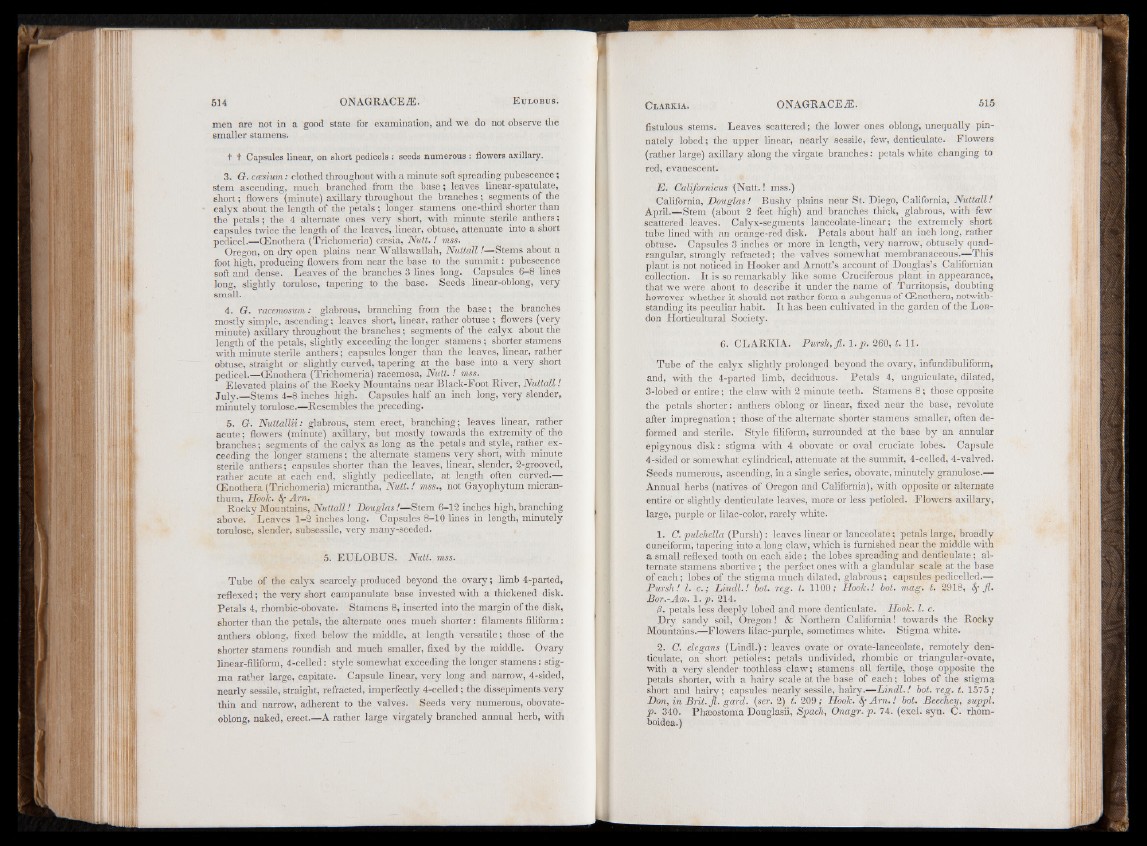
men are not in a good state for examination, and we do not observe the
smaller stamens.
+ t Capsules linear, on short pedicels : seeds numerous : flowers axillary.
3. G. ctssium : clothed throughout with a minute soft spreading pubescence ;
stem ascending, much branched from the base ; leaves linear-spatulate,
short ; flowers (minute) axillary throughout the branches ; segments of the
calyx about the length of the petals ; longer stamens one-third shorter than
the petals ; the 4 alternate ones very short, with minute sterile anthers ;
capsules twice the length of the leaves, linear, obtusé, attenuate into a short
pedicel.—OEnothera (Trichomeria) cæsia, Nutt. ! mss.
Oregon, on dry open plains near Wallawallah, Nuttall !—Stems about a
foot high, producing flowers from near the base to the summit : pubescence
soft and dense. Leaves of the branches 3 lines long. Capsules 6-8 lines
long, slightly torulose, tapering to the base. Seeds linear-oblong, very
small.
4. G. racemosum: glabrous, branching from the base; the branches
mostly simple, ascending ; leaves short, linear, rather obtuse ; flowers (very
minute) axillary throughout the branches ; segments of the calyx about the
length of the petals, slightly exceeding the longer stamens ; shorter stamens
with minute sterile anthers ; capsules longer than the leaves, linear, rather
obtuse, straight or slightly curved, tapering at the base into a very short
pedicel.—OEnothera (Trichomeria) racemosa, Nutt. ! mss.
Elevated plains of the Rocky Mountains near Black-Foot River, Nuttall !
July.—Stems 4-8 inches high. Capsules half an inch long, very slender,
minutely torulose.—Resembles the preceding.
5. G. Nuttallii: glabrous, stem erect, branching; leaves linear, rather
acute; flowers (minute) axillary, but mostly towards the extremity of the
branches; segments of the calyx as long as the petals and style, rather exceeding
the longer stamens ; the alternate stamens very short, with minute
sterile anthers ; capsules shorter than the leaves, linear, slender, 2-grooved,
rather acute at each end, slightly pedicellate, at length often curved.—
OEnothera (Trichomeria) micrantha, Nutt.! mss., not Gayophytum micran-
thum, Hook. 8ç Arn.
Rocky Mountains, Nuttall ! Douglas !—Stem 6-12 inches high, branching
above. Leaves 1-2 inches long. Capsules 8-10 lines in length, minutely
torulose, slender, subsessile, very many-seeded.
5. EULOBUS. Nutt. mss.
Tube of the calyx scarcely produced beyond the ovary ; limb 4-parted,
reflexed ; the very short campanulate base invested with a thickened disk.
Petals 4, rhombic-obovate. Stamens 8, inserted into the margin of the disk,
shorter than the petals, the alternate ones much shorter : filaments filiform :
anthers oblong, fixed below the middle, at length versatile; those of the
shorter stamens roundish and much smaller, fixed by the middle. Ovary
linear-filiform, 4-celled : style somewhat exceeding the longer stamens : stigma
rather large, capitate. Capsule linear, very long and narrow, 4-sided,
nearly sessile, straight, refracted, imperfectly 4-celled; the dissepiments very
thin and narrow, adherent to the valves. Seeds very numerous, obovate-
oblong, naked, erect.—A rather large virgately branched annual herb, with
fistulous stems. Leaves scattered; the lower ones oblong, unequally pin-
nately lobed; the upper linear, nearly sessile, few, denticulate. Flowers
(rather large) axillary along the virgate branches: petals white changing to
red, evanescent.
E . Californicus -(Nutt.! mss.)
California, Douglas ! Bushy plains near St. Diego, California, Nuttall!
April.—Stem (about 2 feet high) and branches thick, glabrous, with few
scattered: leaves. Calyx-segments lanceolate-linear; the extremely short
tube lined with an orange-red disk. Petals about half an inch long, rather
obtuse. Capsules 3 inches or more in length, very narrow, obtusely quadrangular,
strongly refracted; the valves somewhat membranaceous.—This
plant is not noticed in Hooker and Amott’s account of Douglas’s Californian
collection. It is so remarkably like some Cruciferous plant in appearance^
that we were about to describe it under the name of Turritopsis, doubting
however whether it should not rather form a subgenus of CEnothera, notwithstanding
its peculiar habit. It has been cultivated in the garden of the London
Horticultural Society.
6. CLARKIA. Pursh,fi. 1. p. 260, t. 11.
Tube of the calyx slightly prolonged beyond the ovary, infundibuliform,
and, with the 4-parted limb, deciduous. Petals 4, unguiculate, dilated,
3- lobed or entire; the claw with 2 minute teeth. Stamens 8; those opposite
the petals shorter: anthers oblong or linear, fixed near the base, revolute
after impregnation; those of the alternate shorter stamens smaller, often deformed
and sterile. Style filiform, surrounded at the base by an annular
epigynous disk: stigma with 4 obovate or oval cruciate lobes. Capsule
4- sided or somewhat cylindrical, attenuate at the. summit, 4-celled, 4-valved.
Seeds numerous, ascending, in a single series, obovate, minutely granulose.—
Annual herbs (natives of Oregon and California), with opposite or alternate
entire or slightly denticulate leaves, more or less petioled. Flowers axillary,
large, purple or lilac-color, rarely white.
1. C. pulchella (Pursh): leaves linear or lanceolate; petals large, broadly
cuneiform, tapering into a long claw, which is furnished near the middle with
a small reflexed tooth on each side; the lobes spreading and denticulate; alternate
stamens abortive ; the perfect ones with a glandular scale at the base
of each; lobes of the stigma much dilated, glabrous; capsules pedicelled.—
Pursh! 1. c.; Lincll.! hot. reg. t. 1100 ; Hook.! hot. mag. t. 2918, Sf Jl.
Bor.-Am. 1. p. 214.
/?. petals less deeply lobed and more denticulate. Hook. 1. c.
Dry sandy soil, Oregon! & Northern California! towards the Rocky
Mountains.—Flowers lilac-purple, sometimes white. Stigma white.
2. C. elegans (Lindl.): leaves ovate or ovate-lanceolate, remotely denticulate,
on short petioles; petals undivided, rhombic or triangular-ovate,
with a very slender toothless claw; stamens all fertile, those opposite the
petals shorter, with a hairy scale at the base of each; lobes of the stigma
short and hairy; capsules nearly sessile, hairy.—Lindl.! hot. reg. t. 1575;
Don, in Brit. jl. gard. (ser. 2) t. 209 ; Hook. 8f A rn .! hot. Beechey, suppl.
p. 340. Phseostoma Douglasii, Spach, Onagr. p. 74. (excl. syn. C. rhom-
boidea.)